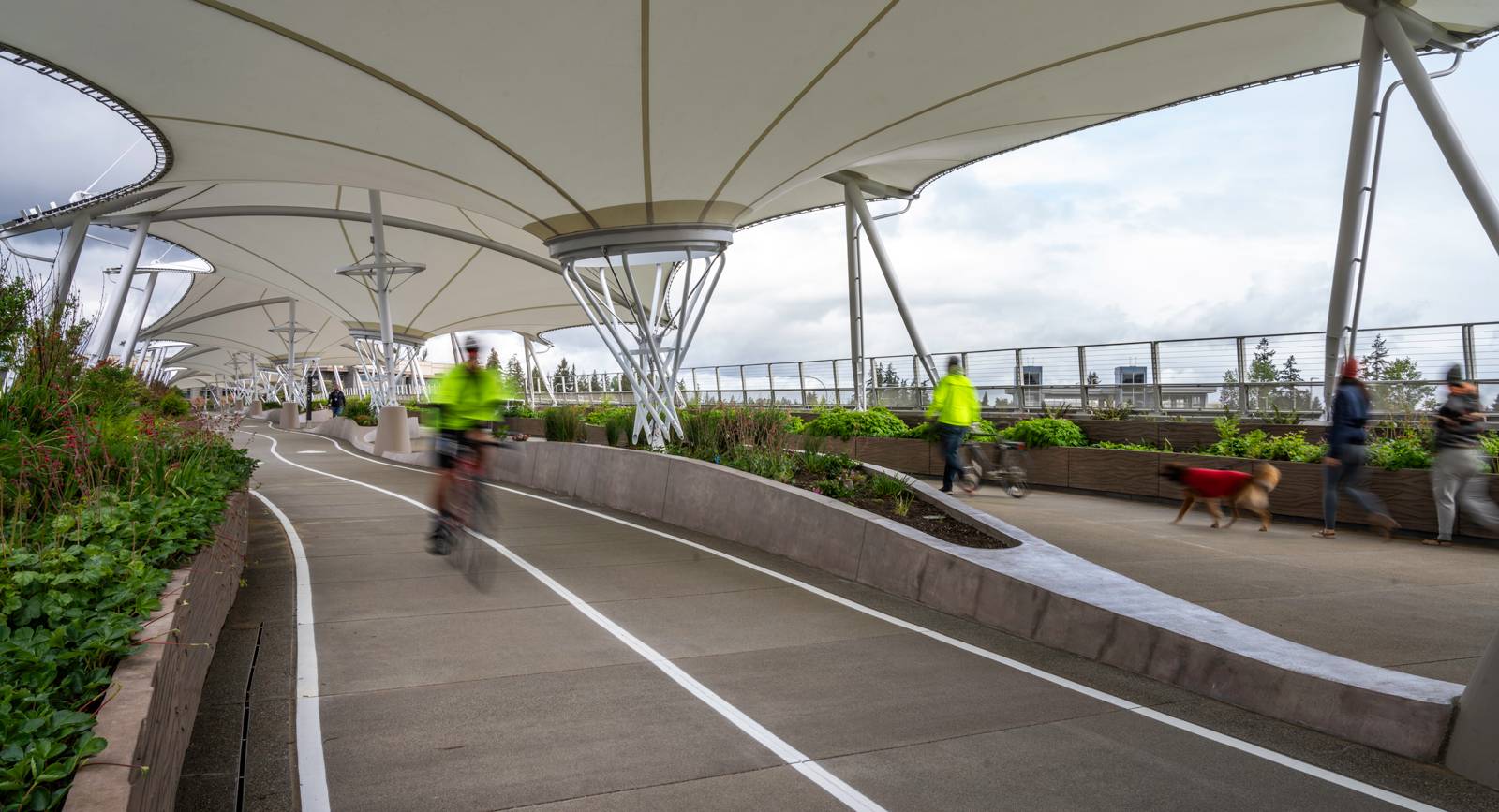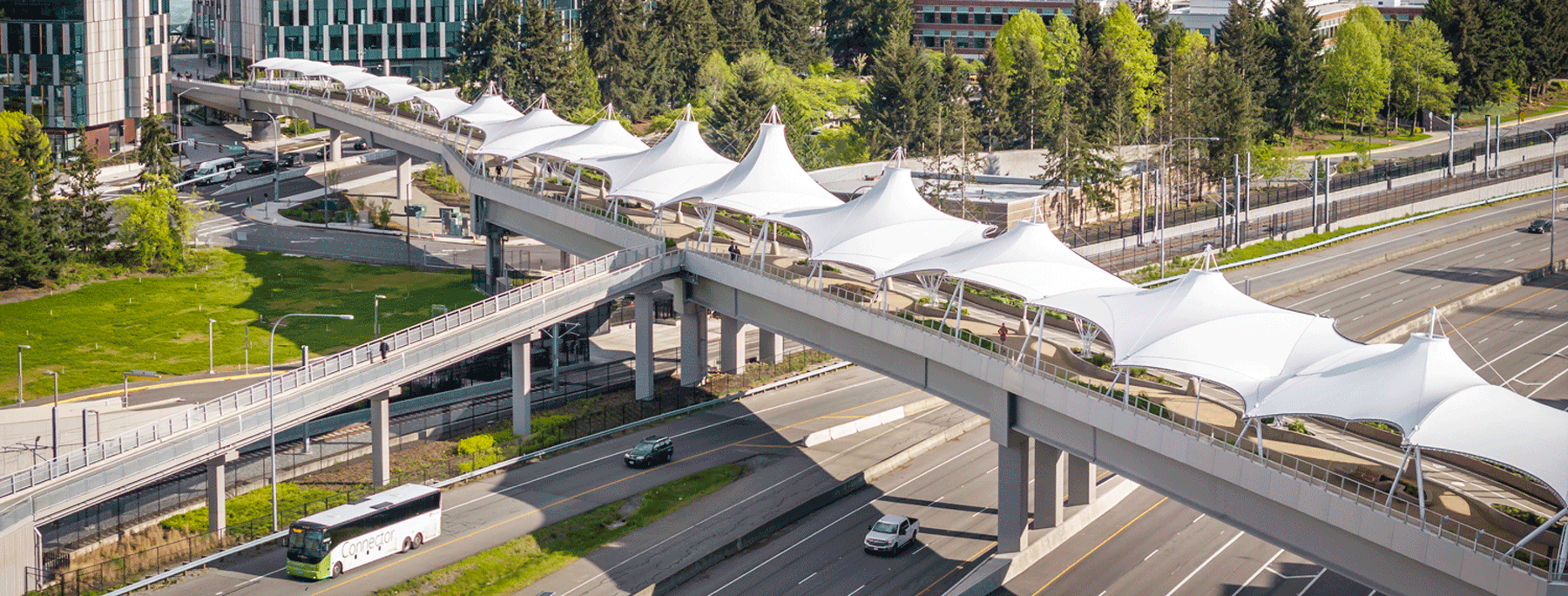A stunning new pedestrian bridge connects Microsoft’s two campuses, expands commuting options and creates an appealing public space for an entire community
DESIGNER
2024
The new Redmond Technology Station (RTS) Bridge transforms mobility, safety and accessibility for pedestrians and cyclists in Redmond, Washington’s Overlake community. Spanning 20 roadway lanes and two light rail tracks, it eliminates the need for walkers and bikers to cross between east and west on 5-foot-wide sidewalks through intersection crossings and a freeway interchange.
The bridge’s opening in April 2024 coincided with the start of service on Sound Transit’s 2 Line at the Redmond Technology Station, which was built as part of the transportation agency’s East Link Extension project. The RTS Pedestrian Bridge provides direct access to Sound Transit’s new light rail station from either side of State Route 520, connecting roads and giving cyclists a new dedicated connection between local and regional bike trails as well as linking the east and west halves of Microsoft’s 500-acre campus.
Sound Transit’s early conceptual plans for the Redmond Technology station included a pedestrian bridge across SR 520 to allow for easy access to the station from both sides of the highway, but still left the station somewhat isolated between the highway and busy local roads. At the same time, Microsoft was planning a campus modernization project that would be enhanced by a connection to the existing campus on the opposite side of the highway.
In a bid to improve the quality and functionality of the crossing for everyone in the neighborhood, the tech company took the lead on design and construction of the bridge that would span the highway and local roads to connect its East and West Campus, the transit station and the local bike trail network.
The new bridge provides Microsoft employees and visitors with a new, more relaxed way to travel back and forth, reducing reliance on the company’s fleet of buses, vans and cars that ferry employees between campuses. It also increases ridership on Sound Transit’s new light rail line and the local bus lines that now have a depot adjacent to the light rail station.
Although Microsoft has employees and regular consultants that manage their vertical construction projects, the company selected HNTB as its RTS Pedestrian Bridge construction manager for its experience in bridge building and the design-build contract model used on the project. HNTB served as the liaison between Microsoft, the general contractor and the design team, managed the project schedule and verified construction quality.
“The refinement of the finish and details needed for a pedestrian bridge are different because people are experiencing the bridge up close,” said Adam Tuff, HNTB resident engineer. “The concrete work and other finishes are extremely high level on this project, consistent with Microsoft’s goals.”
Employee-centric design benefits the community
The 1,100-foot-long RTS Pedestrian Bridge is covered by one-of-a-kind interconnecting, white tensile fabric canopies providing a safe and accessible path that protect users from weather elements. The span also connects users directly to a bus rapid transit stop, a regional bike trail, restaurants and retail spaces on either side of the bridge. A ramp provides direct access to the bridge for passengers leaving the light rail station platform.
As the result of meticulous and innovative planning, the bridge is designed as much more than a utilitarian structure. Wide, separate walking and two-way bike paths invite users to slow down and enjoy traversing the structure. Up to 60 feet across at its widest sections, the span is dotted with precast benches where people can sit to talk and take in the view of the Cascade Mountain range in the distance. Lighting and landscaped planters filled with native plants line the bridge’s length on both sides.
“The RTS Pedestrian bridge shows that infrastructure doesn’t just have to be functional,” said Mark Holmes, HNTB Northwest Division construction services group director. “The bridge provides a fast, easy connection to walk or bike, but people are also using it because it’s beautiful. Since it has opened, people are on the bridge taking photos, sauntering along and taking it in.”
“Our guiding principles for the design were to make it a secure, sustainable and accessible pathway,” said Vanessa Ryan, Microsoft Senior Development Manager. “Part of that accessibility is inclusivity. At Microsoft, we think a lot about the different needs our employees have, which include how they might traverse a bridge over traffic. We care about the employee experience. So, the wheelchair cutouts and the benches were important, and the natural plantings were designed to reduce stimulation from the traffic below.”
While the bridge design was employee experience-driven, Ryan explains that the benefits also extend to the surrounding community.
“Consideration of our employees drove the beauty of the design and contributed to a whole ecosystem on the bridge,” she said. “The space attracts butterflies and birds. It’s delightful, like something from a Disney scene. Every person on the bridge is smiling. As much as we tried to mitigate the traffic noise, there are spots where it can be loud, yet crossing the bridge is still one of the loveliest experiences people will have in the area. This bridge exemplifies how Microsoft shows up not just for its employees, but for the community as well.”
Connecting stakeholders
Although Microsoft owned the project’s construction, the bridge connections intersected with Sound Transit, City of Redmond and Washington Department of Transportation rights of way. Those entities had control over project aspects like placement of storm drainage, location of barriers that protect the bridge piers and traffic management.
“HNTB communicated daily with these key stakeholders to coordinate work activities and gain approvals,” said Shannon McNutt, HNTB construction manager. “In our construction management role, we reviewed every submittal, every request for information, every traffic control plan. We always considered how the project’s key stakeholders would be affected, ensured they had relevant input and returned information to the contractor and designer in a timely manner.”
Construction began in 2019. In the midst of the heaviest construction period, the COVID-19 pandemic escalated material availability challenges and a concrete truck driver strike went on for nearly five months. HNTB worked closely with the contractor to mitigate those issues and maintain progress.
“Every HNTB team member was phenomenal, bringing the highest level of construction management skill,” Ryan said. “There were complex challenges, not just from an engineering standpoint, but also with sometimes-competing stakeholder goals. HNTB was always safety-minded, ethically above board and oriented toward reasonable solutions. The team stewarded the building of this bridge masterfully, keeping it moving and ensuring quality construction. Microsoft couldn’t have asked for a better partner.”
After the bridge opened, its ownership transferred to the City of Redmond, with Microsoft assisting in some of the bridge’s ongoing maintenance costs.


“Every HNTB team member was phenomenal, bringing the highest level of construction management skill. There were complex challenges, not just from an engineering standpoint, but also with sometimes-competing stakeholder goals. HNTB was always safety-minded, ethically above board and oriented toward reasonable solutions. The team stewarded the building of this bridge masterfully, keeping it moving and ensuring quality construction. Microsoft couldn’t have asked for a better partner.”
“The RTS Pedestrian bridge shows that infrastructure doesn’t just have to be functional. The bridge provides a fast, easy connection to walk or bike, but people are also using it because it’s beautiful. Since it has opened, people are on the bridge taking photos, sauntering along and taking it in.”
Linking the west landing
Constrained by existing Microsoft buildings and placed above an underground parking structure, the pedestrian bridge’s west landing was an intricate undertaking in itself. HNTB supported Microsoft on the west landing project by completing a constructability review, which determined that a different type of footings was needed to support the structure’s piers. HNTB later assisted with contractor procurement and served as construction manager.
The finished west landing provides an aesthetically pleasing transition from the RTS Pedestrian Bridge to Microsoft’s west campus, building on design concepts already established on the bridge. An elegant, low-profile design visually opens the approach to the west campus. Finishes, including colored and textured concrete and landscape edge planters, match the bridge design.
Pedestrians use a grand staircase to enter a “mixer plaza” that ushers them onto the west campus. A loop ramp separates from the pedestrian walkway, circling bikers directly to and from the 520 Bike Trail, an important connector to the Seattle metro region’s impressive trail network. The west landing provides ADA-compliant access to the RTS pedestrian bridge via the loop ramp and a glass elevator.
Meeting long-term regional needs
Ryan said the completed RTS Pedestrian Bridge and West Landing, coupled with Sound Transit’s new Redmond Technology Station as part of the East Link Extension, meets key needs for the region.
“Commuting options have become ever more relevant,” she said. “Microsoft was heavily involved in the East Link connection that brought light rail to Redmond. People require the flexibility to strategize their days, their lives and their commutes. The pedestrian bridge solution has made a major difference in how people are planning their days, where they are meeting and how they are connecting.”
As an aesthetically stunning neighborhood landmark, the bridge has quickly become a vibrant public space that enhances safety and improves accessibility for thousands of residents and commuters daily.
CONTACT
Mark Holmes
HNTB Northwest Division Construction Services Group Director
(206) 915-1156
SEE MORE ARTICLES
MORE DESIGNER STORIES
Northaven Trail Bridge
Third Avenue Bridge Rehabilitation
East Link Extension
Sixth Street Viaduct Replacement
Fish Passage
